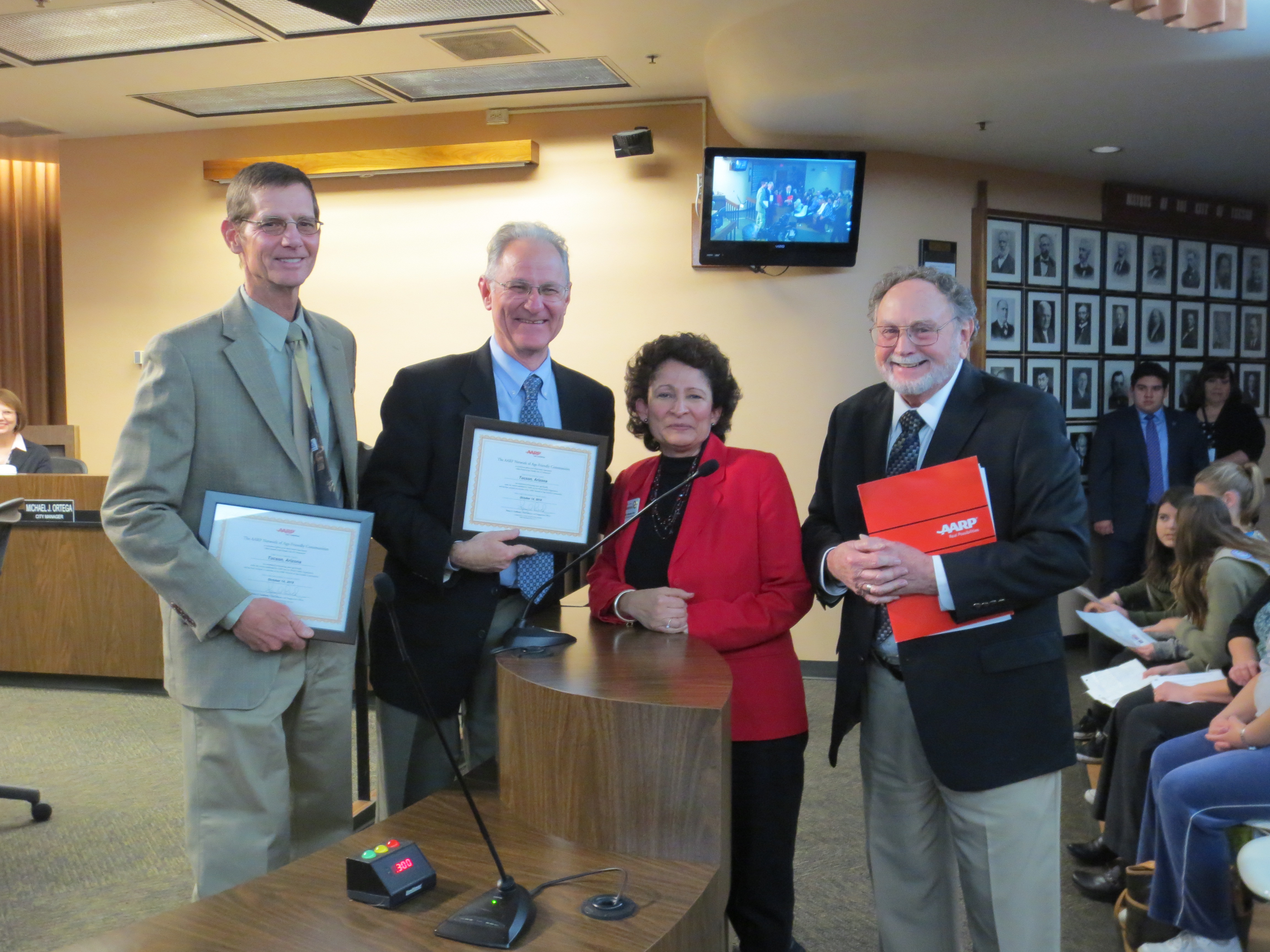AARP Hearing Center

TUCSON, Arizona – On January 24, 2017, AARP presented to Mayor Jonathan Rothschild and the City of Tucson Council the official designation of the AARP Network of Age Friendly Communities. As the 122nd community in the U.S. and first in Arizona to sign on to the network, Tucson’s civic leaders will have access to global resources and information on age-friendly best practices, models of assessment and implementation, and the experiences of towns and cities around the world.
The network helps participating communities become great places for people of all ages by adopting features such as safe, walkable streets; better housing and transportation options; access to key services; and opportunities for residents to participate in civic and community activities.
“Well-designed, livable communities promote wellbeing, sustain economic growth, and make for happier, healthier residents — of all ages,” said AARP State Director Dana Marie Kennedy. “By becoming part of the network, Tucson is making a commitment to do even more to improve livability in the city and involve older residents in the process,” she said.
"Age-friendly design benefits everyone. First, because we all hope to live a long life; and second, because walkability, access to transit, and an absence of barriers, physical or cultural, helps people of all ages and abilities live with greater mobility and independence," said Tucson Mayor Jonathan Rothschild.
The AARP Network of Age-Friendly Communities targets improvements in eight domains that influence the health and quality of life of older adults. Communities participating in the AARP Network of Age-Friendly Communities commit to improving their age-friendliness though an ongoing cycle of improvement and with the involvement of older residents. Those “Livability Indicators” include:
- Outdoor spaces and buildings
- Transportation
- Housing
- Social participation
- Respect and social inclusion
- Civic participation and employment
- Communication and information
- Community support and health services
The livability indicators are planned, implemented and evaluated in three phases over a five-year period, with continued cycles of re-evaluation and improvement thereafter.
Ward 6 City Council Member Steve Kozachik, the lead person from the Mayor and Council noted, “Joining this network demonstrates our commitment to ensuring our seniors have the tools to stay vibrant, independent and engaged in community affairs. I applaud the Elder Alliance for their leadership in this important initiative, and look forward to partnering with them as we assess and develop each of the 8 Livability Indicators included in the Age Friendly Initiative.”
The ELDER Alliance ( www.unitedway.org/elder) is the City’s partner in working towards a more age friendly/livable community. The ELDER Alliance is a broad collaboration that includes representation from non-profit organizations, businesses, government agencies, community partners and of course age-50+ residents dedicated to ensuring older adults thrive, enjoy quality of life, and play an active role in shaping livable communities for all ages in Tucson and surrounding areas. “We are working toward a livable city where residents can take their kids to school, work, buy groceries, and go to the park without having to get in a car,” said Jim Murphy, Chair of the ELDER Alliance’s Age Friendly Community Action Team.
Affiliated with the World Health Organization’s (WHO) Global Network of Age-Friendly Cities and Communities®, the AARP network helps cities and towns to prepare for two significant ongoing trends: rapid population aging and increasing urbanization. According to the 2015 Census, Tucson has a population of 531,641 and 13.3% of the population is over the age of 65. By the year 2030, data indicates that more than 25% of Tucson residents will be over the age of 60.
“The City of Tucson has demonstrated a commitment to work in partnership with other cities and communities across the country to address some of our nation’s most challenging issues, including homelessness, affordable housing, transportation, education, environmental sustainability, and race and social justice,” said Jim Murphy. “We are all eager to bring an age-friendly perspective to these ongoing efforts, and look forward to developing new partnerships to help create communities that support people of all ages in achieving their potential,” he said.
Nationwide, 137 communities representing more than 61 million residents have received the Age-Friendly designation from AARP. Learn more at AARP.org/agefriendly and AARP.org/livable.
###
About AARP:
AARP is a nonprofit, nonpartisan organization, with a membership of nearly 38 million that helps people turn their goals and dreams into 'Real Possibilities' by changing the way America defines aging. With staffed offices in all 50 states, the District of Columbia, Puerto Rico, and the U.S. Virgin Islands, AARP works to strengthen communities and promote the issues that matter most to families such as healthcare security, financial security and personal fulfillment. AARP also advocates for individuals in the marketplace by selecting products and services of high quality and value to carry the AARP name. As a trusted source for news and information, AARP produces the world’s largest circulation magazine, AARP The Magazine and AARP Bulletin. AARP does not endorse candidates for public office or make contributions to political campaigns or candidates. To learn more, visit www.aarp.org or follow @aarp and our CEO @JoAnn_Jenkins on Twitter.































































